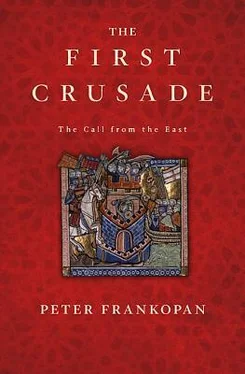This was a major coup for Alexios – and the vindication of his ambitious policy of seeking help from the west. Nevertheless, the situation had to be handled delicately. Fearing that the western knights would not be satisfied by a brokered truce, the emperor gave the order to stage an ‘attack’ on the walls. The aim was to give the impression that it was the Byzantines who breached the defences and successfully took the town, rather than the Crusaders.
On 19 June 1097, while the western army, still unaware of the deal that had been struck, continued its assaults on the town’s fortifications, Byzantine soldiers scaled the walls on the lake side of Nicaea, climbed on to the battlements, and set up the imperial standards above the town. To the sounds of trumpets and horns, the fall of Nicaea and its capture by the forces of the emperor Alexios I Komnenos was announced from the walls of the city. 21
The fall of Nicaea sent shock waves through the Muslim world. As one contemporary writing in Damascus described it: ‘There began to arrive a succession of reports that the armies of the Franks had appeared from the direction of the sea of Constantinople with forces not to be reckoned for multitude ... as reports grew and spread from mouth to mouth far and wide, the people grew anxious and disturbed in mind.’ 22The use of Turkish tombstones to rebuild an area of Nicaea’s walls that had suffered damage during the siege cannot have helped calm nerves about what the implications of the massive western expedition might be elsewhere in Asia Minor. 23
The town’s capture caused a stir closer to home as well. For the Crusaders, it was proof that the expedition to Jerusalem enjoyed divine blessing. As it became clear that the town had fallen, cries of ‘Glory to Thee, O God!’ went up inside and outside the walls, shouted in both Latin and in Greek. 24Nicaea’s capture revealed that the knights were doing the work of the Lord; it was a success they would refer back to when the odds ran sharply against them at later stages in the expedition. There was no such thing as an impregnable target for a force marching under God’s protection.
For Alexios, the recovery of Nicaea had been one of his primary goals. Yet the ambition, speed and determination shown by the western knights had been remarkable. The town’s capture in June 1097 was therefore a comprehensive vindication of the emperor’s decision to call for military assistance from the west. For Alexios this was an unmitigated triumph.
The fact that Nicaea passed into Byzantine hands with little bloodshed also presented future opportunities for the emperor: he would be able to present himself as friend and protector of the Turks who could save them from slaughter at the hands of the knights. This intention was reinforced by the emperor’s treatment of the Turkish inhabitants of Nicaea: having been offered imperial service and generous gifts, all were allowed to go on their way unharmed. 25The Crusaders were also well rewarded: gold, silver and precious robes were given to the expedition’s leaders, while the lower ranks received copper coins to celebrate the fall of the city. 26
Not everyone was impressed by the emperor’s largesse, however. Misgivings began to be articulated about Alexios’ role and about why the emperor should be benefiting from western strength and skill. A leading cleric on the expedition wrote to Manasses II, archbishop of Rheims, some months later, noting that ‘the princes of the army hastened to meet the emperor who had come to express his gratitude to them. After receiving gifts from him of priceless value, they returned, some feeling kindly towards him, others not.’ 27Ironically, it was Alexios’ generosity that caused some of this bitterness. The knights had set out from western Europe to do God’s will and to some, to be financially rewarded by the Byzantines seemed inappropriate.
Alexios’ decision to raise the matter of the oaths once again at Nicaea caused further discontent. Anna Komnene’s claim that her father wanted all those who had previously made commitments to reconfirm them in June 1097 seems unconvincing and is not supported by Latin sources. 28In fact, it was those knights who had not already sworn allegiance that Alexios was seeking to pin down after the fall of Nicaea. Some prominent leaders had escaped his attention in Constantinople. Some, like Tancred, the nephew of Bohemond, had quietly avoided paying homage to the emperor, which he regarded as a yoke of bondage according to his twelfth-century biographer. 29When, after the capture of Nicaea, Tancred too was pressed to take the oath, he protested violently – at least, that is, until he named his price: the same payments as had been given to the other leaders plus some additional incentives. When one Byzantine senior officer lunged at him for his insolence, the two men had to be pulled apart. Once again, it was Bohemond who smoothed things over, persuading Tancred to take the oath. 30
Alexios’ efforts to strengthen his personal authority over the expedition after the fall of Nicaea stemmed from his decision not to join the march across Asia Minor in person – at least not for the time being. Although the emperor had advanced to Nicaea to oversee and witness the fall of the town, he was reluctant to venture deeper into Anatolia. Mindful of the dangers of leaving the capital after the problems he had experienced on the eve of the Crusade, he instead chose an experienced and trusted general to lead the western army east. The obvious choice was the emperor’s childhood friend Tatikios. Gnarled and experienced, Tatikios had long proved his loyalty to Alexios, especially during the denouement of the Diogenes conspiracy. He had a slit nose, which he covered with a gold proboscis – likely the result of his loyalty to the emperor during the fierce infighting of the mid1090s. 31Tatikios was appointed to command the force that was to lead the Crusaders across Asia Minor, and to take possession of any towns captured on the route to Jerusalem. 32
Alexios’ reluctance to take part in the expedition was understandable given the crisis in Byzantium on the eve of the Crusade. The emperor had told Raymond of Toulouse that he could not lead the knights to Jerusalem because ‘he feared that the Alemanni, Hungarians and Cumans and other savage peoples would ravage his empire if he made the journey with the pilgrims’. 33These were real dangers: the Cuman attack in the spring of 1095 had stretched Byzantium to breaking point, leaving the emperor unable to take direct action, having to stage an elaborate ceremony in Hagia Sophia where he placed two tablets on the altar – one saying he should march against the nomads, the other that he should not; the rest was left up to God. 34
In 1097, therefore, the threats to the empire from within and without meant that the risks were simply too high for Alexios to contemplate taking the lead in person. As we shall see, a year later, when desperate reports from Antioch reached Alexios, begging him to head east to relieve the embattled Crusade force which was by that time on the edge of annihilation, there was little the emperor could do to help. The weakness of his position at the time of his appeals to the west underpinned the First Crusade. Nevertheless, Alexios still retained control of the expedition in 1097; although some of the knights agitated to press straight on with their journey after the fall of Nicaea, it was only when the emperor gave his permission to depart that the Crusaders got on their way at the end of June. 35
Meanwhile the emperor stayed in northern Asia Minor, monitoring Byzantine attempts to recover the western coast and river valleys of the subcontinent. As soon as Nicaea was secure, Alexios equipped a force and placed it under the command of John Doukas and Constantine Dalassenos, with orders to move on Çaka’s base at Smyrna. From there, they were to retake the other towns on the coast that had fallen to the Turks before turning inland, with Doukas marching up the Maiander valley, while in a flanking movement, Dalassenos was to head north to Abydos. The aim was to recover a substantial swathe of territory in western Asia Minor. 36
Читать дальше











